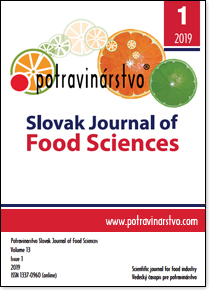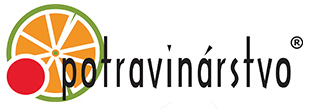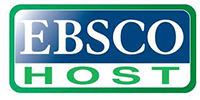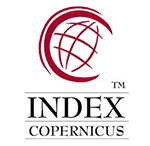Detection of microbiota in the vineyards of the Tokaj wine region
DOI:
https://doi.org/10.5219/1246Keywords:
microbiota wines, terroir, ITS-PCR-RFLP, yeastAbstract
Tokaj is an important Central European wine-growing area with controlled planting and authorized varieties of white vines. This area has a specific microflora composition which changes based on its climate dependence, as well as during the fermentation process of wine production. Therefore, the aim of this study was, by culture examination of the samples, to detect the microbiota of soil, leaves, berries and fermentation must from two vineyards from the Slovak part of Tokaj. The highest total viable count (5.60 ±0.01 log cfu.g-1) and the highest total yeast and mould count (4.32 ±0.01 log cfu.g-1) in soil samples were recorded in vineyard Berecký. The highest total viable count in soil samples (6.71 ±0.01 log cfu.g-1) was confirmed by examination of samples originating from the vineyard of Čierna Hora. When determining the total yeast and mould count, the highest numbers were recorded in the must samples (4.15 ±0.01 log cfu.mL-1). Lactic acid bacteria were collected in samples from both vineyards, only in very low numbers. Overall, statistically significant differences (p <0.001) were detected by comparing the microbiota of the samples taken from the Berecký and Čierna Hora vineyards. The specific characterisation and identification of yeast was carried out using ITS-PCR-RFLP methods. The analysis confirmed the presence of yeasts of Saccharomyces cerevisiae, Zygosaccharomyces bailii, Zygosaccharomyces rouxii, Candida parapsilosis and Candida tenuis and their subsequent transfer to the must at varying percentages.
Downloads
Metrics
References
Albergaria, H., Arneborg, N. 2016. Dominance of Saccharomyces cerevisiae in alcoholic fermentation processes; role of physiological fitness and microbial interactions. Applied Microbiology and Biotechnology, vol. 100, no. 5, p. 2035-2046. https://doi.org/10.1007/s00253-015-7255-0 DOI: https://doi.org/10.1007/s00253-015-7255-0
Barata, A., Malfeito-Ferreira, M., Loureiro, V. 2012. The microbial ecology of wine grape berries. International Journal of Food Microbiology, vol. 153, no. 3, p. 243-259. https://doi.org/10.1016/j.ijfoodmicro.2011.11.025 DOI: https://doi.org/10.1016/j.ijfoodmicro.2011.11.025
Baroň, M. 2017. Terroir, terroir and terroir again (Terroir, terroir a zase terroir). Vinič a víno. vol. 17, no. 6, p. 188-189. (In Slovak)
Bartowsky, E. 2017. Microbiology of winemaking. Microbiology Australia. vol. 38, no. 2. p. 76-79. DOI: https://doi.org/10.1071/MA17033
González, S. S., Barrio, E., Querol, A. 2007. Molecular identification and characterization of wine yeasts isolated from Tenerife (Canary Island, Spain) Journal of Applied Microbiology vol. 102, no. 4, p. 1018-1025. https://doi.org/10.1111/j.1365-2672.2006.03150.x DOI: https://doi.org/10.1111/j.1365-2672.2006.03150.x
Farkaš, J. 2002. All about wine: the secrets of wine quality (Všetko o víne: tajomstvá kvality vína). 2nd ed. MARTIN, SLOVAKIA: Neografia, a.s., 171 p. (In Slovak) ISBN 80-88892-47-3.
Fleet, G. H. 2008. Wine yeasts for the future. FEMS Yeasts Research, vol. 8, no. 7, p. 979-995. https://doi.org/10.1111/j.1567-1364.2008.00427.x DOI: https://doi.org/10.1111/j.1567-1364.2008.00427.x
Fugelsang, C. K., Edwards, G. C. 2007. Wine microbiology. 2nd ed. NEW YORK, USA: Springer publishing media, 393 p. ISBN 978-0-387-33341-0.
Furdíková, K., Kakaš, M., Malík, F. 2015. Technology of Tokaj wine production (Technológia výroby tokajských vín). (In Slovak) Available at:
http://www.agroporadenstvo.sk/rastlinna-vyroba-vinic-a-vino?article=755
STN ISO 21527-1:2010. Microbiology of food and animal feeding stuffs. Horizontal method for the enumeration of yeasts and moulds. Part 1: Colony count technique in products with water activity greater than 0.95. Bratislava: Slovak Standards Institute.
STN EN ISO 4833-1:2014. Microbiology of food chain. Horizontal method for the enumeration of microorganisms. Part 1: Colony count at 30 degrees C by the pour plate technique. Bratislava: Slovak Standards Institute.
STN EN ISO 6887-1:2017. Microbiology of the food chain - Preparation of test samples, initial suspension and decimal dilutions for microbiological examination - Part 1: General rules for the preparation of the initial suspension and decimal dilutions. Bratislava: Slovak Standards Institute.
Jackson, S. J. 2008. Wine science: Principles and aplications. 3rd ed. LONDON, UK: Elsevier, 776 p. ISBN 978-0-12-373646-8.
Kačániová, M., Kunová, S., Felsöciová, S., Ivanišová, E., Kántor, A., Žiarovská, J., Puchalski, C., Terentjeva, M. 2019. Microbiota of different wine grape berries. Potravinarstvo Slovak Journal of Food Sciences, vol. 13, no. 1, p. 174-181. https://doi.org/10.5219/1047 DOI: https://doi.org/10.5219/1047
Kačániová, M., Terentjeva, M., Felsöciová, S., Ivanišová, E., Kunová, S., Žiarovská, J., Kluz, M., Hanus, P., Puchalski, C., Kántor, A. 2018. Bacteria and yeasts isolated from different grape varieties. Potravinarstvo Slovak Journal of Food Sciences, vol. 12, no. 1, p. 108-115. https://doi.org/10.5219/878 DOI: https://doi.org/10.5219/878
Kántor, A., Mareček, J., Ivanišová, E., Terentjeva, M., Kačániová, M. 2017. Microorganisms of grape berries. Proceedings of the Latvian academy of sciences, vol. 71, no. 6, p. 502-508. https://doi.org/10.1515/prolas-2017-0087 DOI: https://doi.org/10.1515/prolas-2017-0087
Knight, S., Klaere, S., Fedrizzi, B., Goddard, M. R. 2015. Regional microbial signatures positively correlate with differential wine phenotypes: evidence for a microbial aspect to terroir. Scientific Reports, vol. 5, no. 14233, p. 1-10. https://doi.org/10.1038/srep14233 DOI: https://doi.org/10.1038/srep14233
Maffezzoli, D. 2017. Spoiler Alert: Zygosaccharomyces rouxii and it's role in food spoilage and fermentation. MicrobeWiki. Available at: https://microbewiki.kenyon.edu/index.php/Spoiler_Alert:_Zygosaccharomyces_Rouxii_and_It%27s_Role_in_Food_Spoilage_and_Fermentation.
Nedomová, Š., Kumbár, V., Pavloušek, P., Pytel, R., Začal,
J., Buchar, J. 2016. Influence of harvest day on changes in mechanical prorties of grape. Potravinarstvo Slovak Journal of Food Sciences, vol. 10, no. 1, p. 181-187. https://doi.org/10.5219/600 23 DOI: https://doi.org/10.5219/600
Pandey, A., Negi, S., Soccol, C. R. 2016. Current Developments in Biotechnology and Bioengineering: Production, Isolation and Purification of Industrial Products. 1st ed. LONDON, UK : Elsevier, 886p. ISBN 9780444636737.
Piknová, Ľ., Jankura E. 2019. Identification of yeast from vineyards with different management (Identifikácia kvasiniek z vinohradov s rôznym obhospodarovaním). Vinič a Víno, vol. 3, p. 88-90. (In Slovak) Available at: http://www.vinicavino.sk/vinarsky-vyskum/identifikacia-kvasiniek-z-vinohradov-s-roznym-obhospodarovanim/.
Piknová, Ľ., Pangallo, D., Ženišová, K., Bučková, M., Puškárová, A. 2017. Microbiological diversity in the process of producing ice wine of the Veltliner variety (Mikrobiologická diverzita v procese výroby ľadového vína odrody Veltlínske zelené). Vinič a Víno, vol. 4, p. 120-121. (In Slovak) Available at: http://www.vinicavino.sk/vinohradnicky-vyskum/mikrobiologicka-diverzita-v-procese-vyroby-ladoveho-vina-odrody-veltlinske-zelene/.
Raymond Eder, M. L., Reynoso, C., Lauret, S. C., Rosa, A. L. 2017. Isolation and identification of the indigenous yeast population during spontaneous fermentation of Isabella (Vitislabrusca L.) grape must. Frontiers in Microbiology, vol. 8, p. 532. https://doi.org/10.3389/fmicb.2017.00532 DOI: https://doi.org/10.3389/fmicb.2017.00532
R Core Team. R: 2019. A Language and Environment for Statistical Computing version 3.6.1 ("Action of the Toes"). Vienna: R Foundation for Statistical Computing.
Rossi, F., Gaio, E., Torriani, S. 2010. Staphylococcus aureus and Zygosaccharomyces bailii as primary microbial contaminants of a spoiled herbal food supplement and evaluation of their survival during shelf life. Food Microbiology, vol. 27, no. 3, p. 356-362. https://doi.org/10.1016/j.fm.2009.11.011 DOI: https://doi.org/10.1016/j.fm.2009.11.011
Sadel, P. 2016. Identification of yeasts from interspecific variets of grapes (Identifikace kvasinek z interspecifické odrůdy vinné révy). Thesis. Brno, Czech Republic: Brno University of Technology.
Semjon, B., Král, M., Pospiech, M., Reitznerová, A., Maľová, J., Tremlová, B., Dudriková, E. 2018. Application of multiple factor analysis for the descriptive sensory evaluation and instrumental measurements of bryndza cheese as affected by vacuum packaging. International Journal of Food Properties, vol. 21, no. 1, p. 1508-1522. https://doi.org/10.1080/10942912.2018.1494194 DOI: https://doi.org/10.1080/10942912.2018.1494194
SHMU 2018. Climate reporting (Klimatologické spravodajstvo). (In Slovak) Available at: http://www.shmu.sk/sk/?page=1&id=klimat_operativneudaje2&identif=11968&rok=2018&obdobie=1981-2010.
Sipiczki, M., Romano, P., Lipani, G., Miklos, I., Antunovics, Z. 2001. Analysis of yeasts derived from natural fermentation in a Tokaj winery. Antonie van Leeuwenhoek, vol. 79, no. 1, p. 97-105. https://doi.org/10.1023/A:1010249408975 DOI: https://doi.org/10.1023/A:1010249408975
Spano, G., Torriani, S. 2016. Editorial: Microbiota of grapes: Positive and negative role on wine quality. Frontiers in Microbiology, vol. 7, p. 20-36. https://doi.org/10.3389/fmicb.2016.02036 DOI: https://doi.org/10.3389/fmicb.2016.02036
Varela, C., Borneman, A. R. 2016. Yeast found in vineyards and wineries. Yeast, vol. 34, no. 3, p. 111-128. https://doi.org/10.1002/yea.3219 DOI: https://doi.org/10.1002/yea.3219
White, T. J., Bruns, T. D., Lee, S. B., Taylor, J. W. 1990. Amplification and direct sequencing of fungal ribosomal RNA genes for phylogenetics. In: Innis, M. A. et al. PCR Protocols: A guide to methods and applications. NEW YORK, USA: Academic Press, p. 315-322. ISBN-978-0-12-372180-8. https://doi.org/10.1016/B978-0-12-372180-8.50042-1 DOI: https://doi.org/10.1016/B978-0-12-372180-8.50042-1
Ženišová, K., Chovanová, K., Chebeňová-Turcovská, V., Godálová, Z., Kraková, L., Kuchta, T. 2014. Mapping of wine yeast and fungal diversity in the Small Carpathian wine-producing region (Slovakia): Evaluation of phenotypic, genotyypic and culture-independent approaches. Annals of Microbiology, vol. 64, no. 4, p. 1819-1828. https://doi.org/10.1007/s13213-014-0827-x DOI: https://doi.org/10.1007/s13213-014-0827-x
Published
How to Cite
Issue
Section
License
This license permits non-commercial re-use, distribution, and reproduction in any medium, provided the original work is properly cited, and is not altered, transformed, or built upon in any way.






























